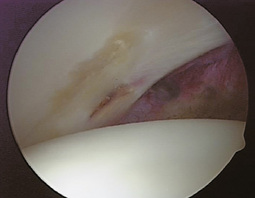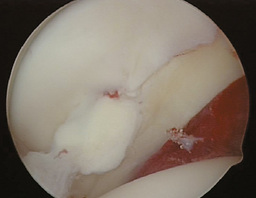CHAPTER 13 Arthroscopic Labral Debridement
Basic science and rationale for treatment
Microvascular studies have confirmed that the vascular supply of the acetabular labrum comes via the obturator artery, the superior gluteal artery, and the inferior gluteal artery, which are the same vessels that supply the bony structure of the acetabulum. These studies also showed no evidence of the penetration of vessels from the underlying acetabular bone into the labral substance. Labral tears most frequently occur on the articular nonvascular white zone, and they will not heal with conservative treatment. These tears are often delaminating tears that are not amenable to suture repair (Figure 13-1).
Labral tears are most frequently seen in the anterior acetabular quadrant (more than 90% in most series), and they are common in patients with degenerative hip disease or acetabular dysplasia. A common finding even with mild acetabular dysplasia is hypertrophy of the anterior labrum, which makes this area more susceptible to tearing. Because of the avascularity and degenerative nature of these lesions, they too are usually not amenable to suture repair (Figure 13-2). Posterior labral tears are most frequently seen after a posterior hip dislocation. Lateral tears are usually associated with additional labral and acetabular lesions.
< div class='tao-gold-member'>











